15 Birds With Orange Heads (with Pictures)
Last Updated on
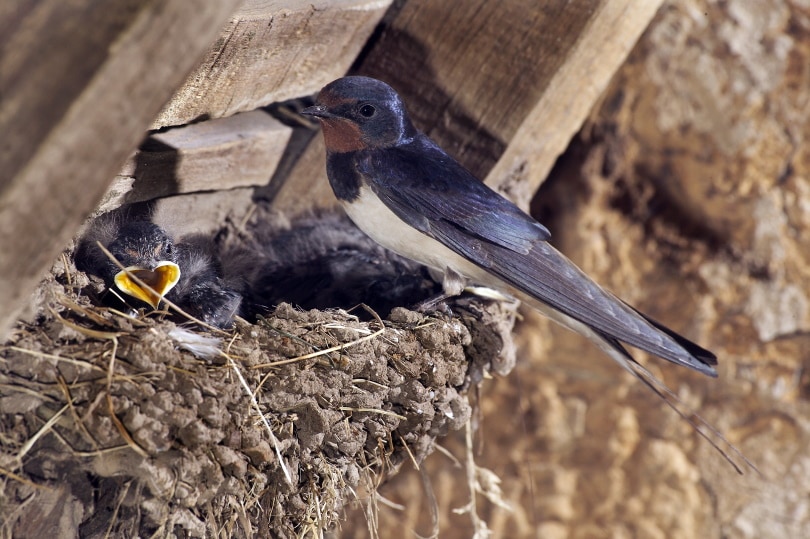
Birds are truly stunning animals that can have a variety of looks and colors. Some of the prettiest birds have bright, colorful feathers that make them stand out in the crowd. There are thousands of unique species, all with different characteristics and traits—including orange heads!
If you’ve recently spotted a bird with an orange head and were wondering what the species may be, here’s a list of 15 of the most common birds with orange heads.
Continue reading to learn more about them and check out their fantastic colors.

The 15 Common Bird Species With Orange Heads
1. Flame-colored Tanager
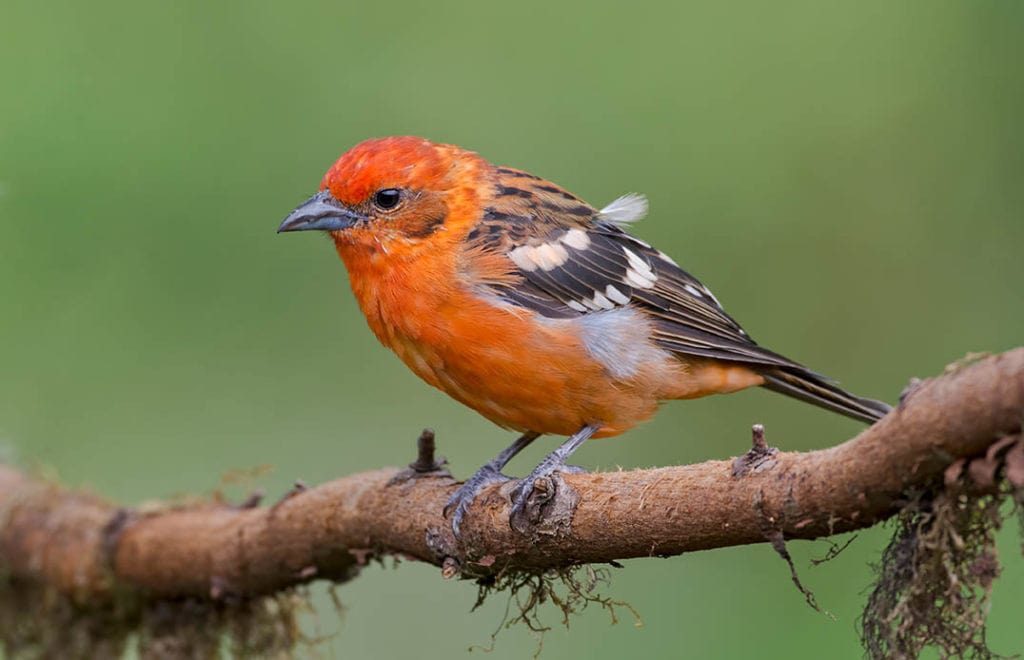
| Scientific name | Piranga bidentata |
| Habitat | Mountain forests |
| Wingspan | 12 inches |
| Length | 7.5 inches |
| Diet | Omnivore |
The Flame-colored Tanager is a bird native to Mexico, Panama, and Central America. It’s a medium-sized bird whose former name was the Stripe-backed Tanager. The body and head of this bird are bright-orange, with black wings and white spots and wing bars. The Flame-colored Tanager is an omnivore, meaning it feeds on both insects and fruit. This bird is nowadays more similar to the cardinal family than the tanager family, where it used to belong.
2. Barn Swallow

| Scientific name | Hirundo rustica |
| Habitat | Parks, lakes, beaches |
| Wingspan | 12.5–13.5 inches |
| Length | 5.9–7.8 inches |
| Diet | Insectivore |
The Barn Swallow is an interesting bird species you can encounter worldwide. Their head is half black and half orange, making these birds very distinctive. They are medium-sized and tend to live in areas such as parks, beaches, lakes, or even agricultural fields. These birds are insectivores, so they only feed on insects. Females and males look alike, although females have shorter tail feathers. The immatures are also similar, but their colors are paler, and their feathers are shorter.
3. Bullock’s Oriole

| Scientific name | Icterus Bullockii |
| Habitat | Forests, parks, orchards |
| Wingspan | 12.2 inches |
| Length | 6.7-7.5 inches |
| Diet | Omnivore |
Bullock’s Oriole is a medium-sized bird, and both female and male species have orange heads. These birds are omnivores, so they frequently hunt for caterpillars and feed on fruit. They are related to the Blackbird species and share certain similarities in their appearance. It’s a bird common to the western parts of the USA, and it mostly spends winters in South America and Mexico. The species got its name after William Bullock, who was an English naturalist.
4. Altamira Oriole
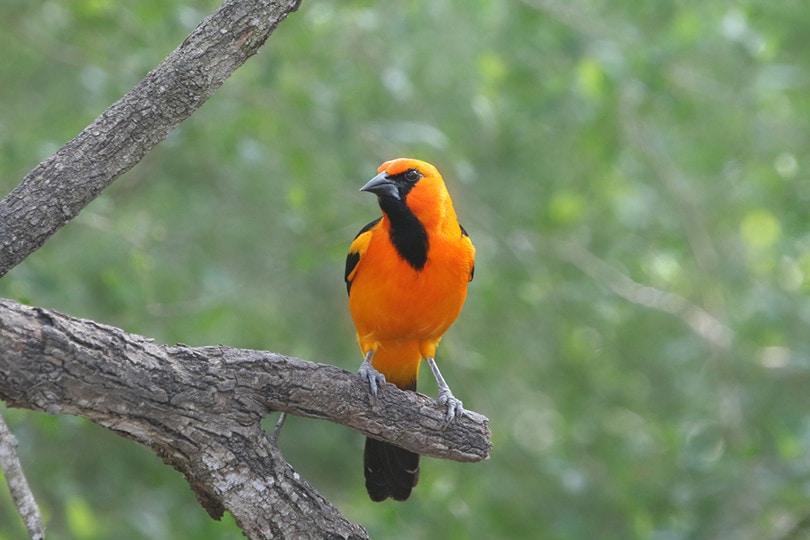
| Scientific name | Icterus gularis |
| Habitat | Shrubby woodland, parks, farms, orchards |
| Wingspan | 14.2 inches |
| Length | 8.3–9.8 inches |
| Diet | Omnivore |
Altamira Oriole is a large bird with a long tail, typical to the USA and Mexico. It has black wings and an orange head, and it’s one of the largest Oriole species in the US. Females and males are very similar, although immatures are yellowish-orange. They commonly live in shrubby woodlands, parks, farms, and orchards. You can attract these birds to your backyard by offering fruits, especially oranges. This bird breed is non-migratory, which is not too common for Orioles.
5. Spot-breasted Oriole
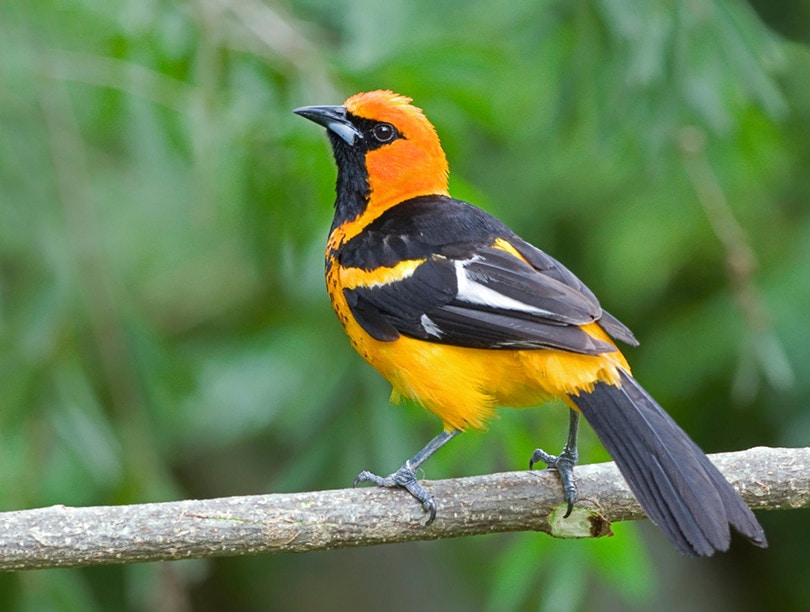
| Scientific name | Icterus pectoralis |
| Habitat | Woodland, riverside, parks |
| Wingspan | 3.5–4.5 inches |
| Length | 8.3–9.4 inches |
| Diet | Omnivore |
The Spot-breasted Oriole is native to Central America and Mexico. It’s a medium-sized bird, distinctive due to its bright orange color and black beak. Males and females are very similar, although females are olive-green on their backs. The female representatives of the species often sing, and you can attract them to your backyard. Baby birds tend to be yellowish in color until they grow up. These birds feed on fruits and insects, depending on what they can find in their environment.
6. Northern-red Bishop

| Scientific name | Euplectes franciscanus |
| Habitat | Tall grasslands, |
| Wingspan | 7.5–8.5 inches |
| Length | 5.1–5.9 inches |
| Diet | Omnivore/insectivore |
The Northern-red Bishop is a small bird species native to Africa but commonly found in the Houston area and southern California. Male representatives of the species have an orange head with black marks and a black belly. On the other hand, females are duller and have a brown/white pattern. These birds are singers, and they produce twittering, squeaky sounds. The Northern-red Bishop mainly eats grass, but you can often catch them eating insects too.
7. Olive Warbler

| Scientific name | Peucedramus taeniatus |
| Habitat | Pine forests, woodlands |
| Wingspan | 7–9 inches |
| Length | 5.1–5.5 inches |
| Diet | Insectivore |
The Olive Warbler is a small songbird native to the USA and Mexico. The males of this species have an orange head with black cheeks. Females are not as bright, while immature birds are even less colorful. This species feeds only on insects and can be non-migratory. The Olive Warbler is technically not a warbler, and instead, it has a distinctive breed category. You can find them in pine forests and woodlands, commonly above 6,000 feet.
8. Ruddy Kingfisher
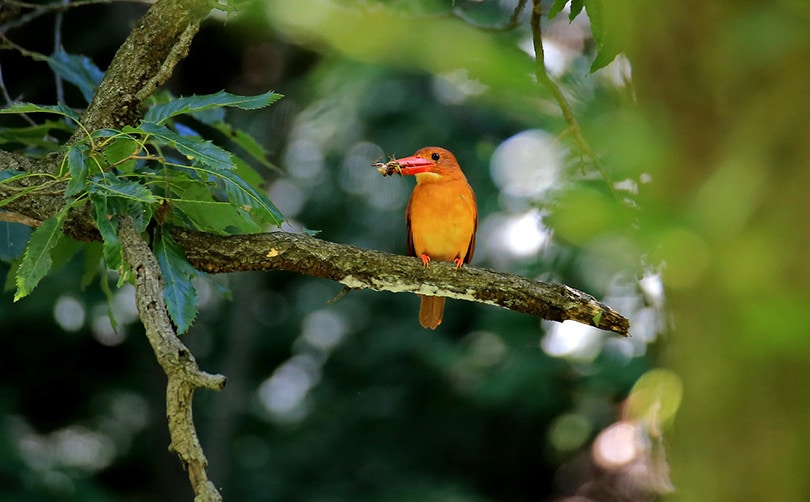
| Scientific name | Halcyon coromanda |
| Habitat | Forests, jungles, rainforests |
| Wingspan | Unknown |
| Length | 9.8 inches |
| Diet | Omnivore |
The Ruddy Kingfisher is a medium-sized bird native to Asia, and you can find them throughout China, South Korea, and Japan. It has a unique orange pattern throughout its body, and the shades vary from being the brightest on the head and darker on the wings. This bird is an omnivore and feeds on fish, insects, frogs, and sometimes fruit that they can easily catch due to their large beak. Their natural habitat is usually forests, jungles, rainforests, or any other shaded area with plenty of water.
9. Cassia Crossbill
https://www.instagram.com/p/CWBzdqmF1WI/
| Scientific name | Loxia sinesciuris |
| Habitat | Pine forests |
| Wingspan | 10–10.75 inches |
| Length | 5–9 inches |
| Diet | Omnivore |
The Cassia Crossbill is a bird species you can commonly encounter in Idaho. They were recognized as a distinct bird breed in 2017. The males have a mix of orange, red and yellow tones, while the females are grayish-green. These birds spend their time in pine forests, and you can only find them in Albion Mountains and South Hills in Idaho. They commonly feed on seeds, and they need a bit of salt in their diet.
10. Guianan Cock-Of-The-Rock
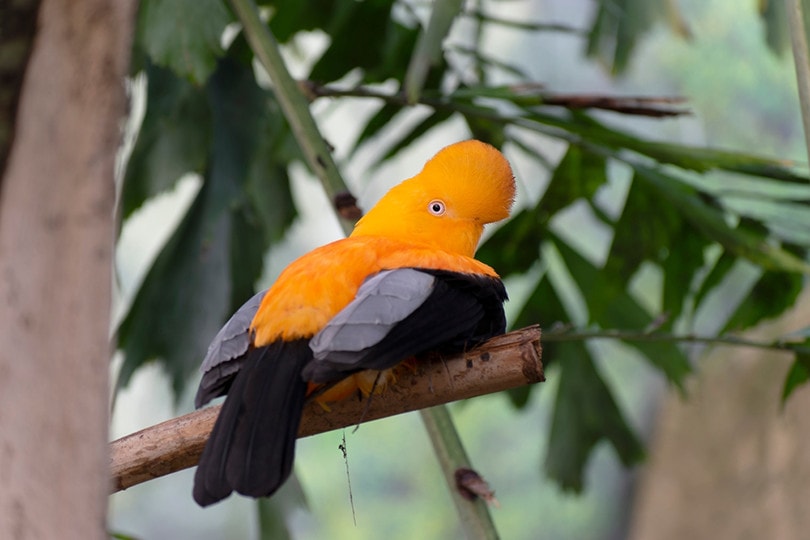
| Scientific name | Rupicola rupicola |
| Habitat | Forests, tropical rainforests |
| Wingspan | Unknown |
| Length | 12 inches |
| Diet | Frugivore/omnivore |
The Guianan Cock-Of-The-Rock is a bird native to South America. It’s unique due to the bright-orange color throughout its body, although only male representatives of the species look this way. The females and immatures are brownish, and you can also recognize them by size. These birds are frugivores/omnivores, meaning they eat raw fruits, fruit-like succulent products, as well as seeds and insects. They live in forests and tropical rainforests, particularly near rocky areas.
11. Andean Cock-Of-The-Rock
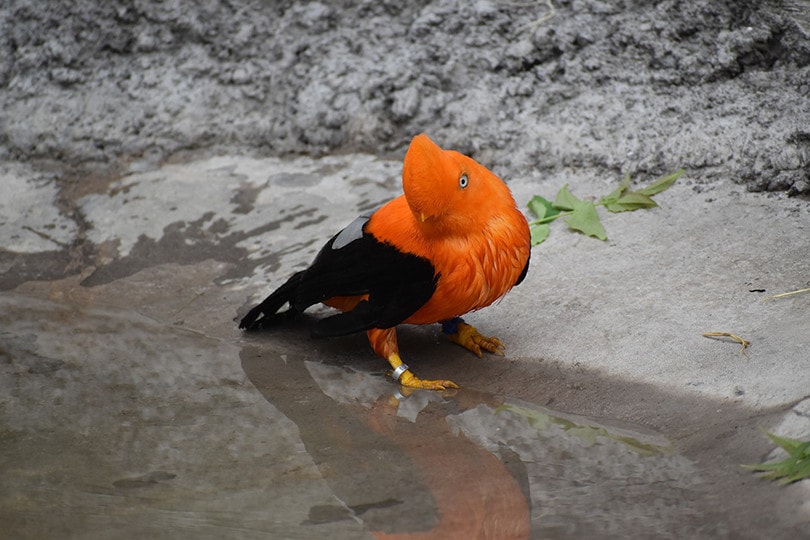
| Scientific name | Rupicola peruvianus |
| Habitat | Mountainous regions |
| Wingspan | Unknown |
| Length | 12 inches |
| Diet | Omnivore |
The Andean Cock-Of-The-Rock is another bird native to South America, and it’s the national bird of Peru. It has bright-orange feathers on its head and black feathers on its wings and back. Females are less colorful, and their colors are paler. You can commonly find them in mountainous areas, from Venezuela and Peru to Bolivia. These birds mainly eat fruit, although they occasionally consume berries and insects too. They also eat small mice and reptiles from time to time.
12. Flame Bowerbird
https://www.instagram.com/p/CThPVtMHuRV/
| Scientific name | Sericulus ardens |
| Habitat | Rainforests |
| Wingspan | Unknown |
| Length | 9.8 inches |
| Diet | Omnivore |
The Flame Bowerbird is the most colorful and bright bird on our list. The males have an orange head and a bright yellow body, while the females are brownish with a yellow belly. Another trait that makes them stand out from other birds is their yellow eyes. They can be found in rainforests in New Guinea, and they are omnivore birds. When courting, these birds can puff up, and they can build stunning bowers to attract potential mates.
Related Read: 18 Birds with Yellow Heads (with Pictures)
13. Hawaii ‘Akepa
https://www.instagram.com/p/CTT95kirkO_/
| Scientific name | Loxops coccineus |
| Habitat | Forests |
| Wingspan | 2.5–2.75 inches |
| Length | 4 inches |
| Diet | Insectivore |
The Hawaii ‘Akepa, also known as the Hawaii Honeycreeper, is a songbird native to Hawaii. It’s a small bird species, distinctive due to its vivid orange color. They are a rare species that you can find in forests above 5000 feet, only in Hawaii. This bird is an insectivore, meaning it feeds on insects such as spiders, although they also drink nectar from fruits. They are singing birds that have short, warbling songs.
14. Orange-headed Thrush

| Scientific name | Geokichla citrina |
| Habitat | Woodlands, damp areas |
| Wingspan | Unknown |
| Length | 8.1–9.25 inches |
| Diet | Omnivore |
The Orange-headed Thrush is a bird commonly found throughout Asia and the Indian Subcontinent. These birds are omnivores, so they mostly eat insects, fruits, and worms. As the name says, their heads are orange, and the color continues to their bellies, while is gray-blue on their wings. You can find these birds in woodlands and damp areas throughout India, Sri Lanka, Bangladesh, and even China. These birds are typically shy, and you can often find them in pairs.
15. Scarlet-headed Blackbird

| Scientific name | Amblyramphus holosericeus |
| Habitat | Riversides, swamps, edges of canals |
| Wingspan | 12–16 inches |
| Length | 9 inches |
| Diet | Omnivore |
The Scarlet-headed Blackbird is commonly found in South America. This is a smaller songbird, and it’s known for its orange head. Males and females look the same, although young birds are completely black. You can spot them in Uruguay, Paraguay, Argentina, and Brazil. In the non-breeding season, you can notice these birds in large flocks. These birds are monogamous and only have one mating partner. Their diet is omnivorous, so they eat both fruits and insects.

Final Thoughts
Above are 15 common species of birds with orange heads. We hope every bird lover was able to find out more about these exciting species that exist worldwide! Each species is distinctive and has unique habitats, traits, and appearances.
Featured Image Credit: slowmotiongli, Shutterstock
Table of Contents
- The 15 Common Bird Species With Orange Heads
- 1. Flame-colored Tanager
- 2. Barn Swallow
- 3. Bullock’s Oriole
- 4. Altamira Oriole
- 5. Spot-breasted Oriole
- 6. Northern-red Bishop
- 7. Olive Warbler
- 8. Ruddy Kingfisher
- 9. Cassia Crossbill
- 10. Guianan Cock-Of-The-Rock
- 11. Andean Cock-Of-The-Rock
- 12. Flame Bowerbird
- 13. Hawaii ‘Akepa
- 14. Orange-headed Thrush
- 15. Scarlet-headed Blackbird
- Final Thoughts
About the Author Robert Sparks
Robert’s obsession with all things optical started early in life, when his optician father would bring home prototypes for Robert to play with. Nowadays, Robert is dedicated to helping others find the right optics for their needs. His hobbies include astronomy, astrophysics, and model building. Originally from Newark, NJ, he resides in Santa Fe, New Mexico, where the nighttime skies are filled with glittering stars.
Related Articles:
Monocular vs Telescope: Differences Explained (With Pictures)
10 Types of Hummingbirds in Arkansas (With Pictures)
8 Types of Hummingbirds in Nebraska (With Pictures)
5 Types of Hummingbirds in Idaho (With Pictures)
3 Types of Hummingbirds in Mississippi (With Pictures)
8 Types of Hummingbirds in Kansas (With Pictures)
5 Types of Hummingbirds in West Virginia (With Pictures)
5 Types of Hummingbirds in Ohio (With Pictures)
